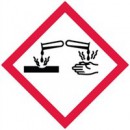Guest blogger Chandra Deeds Gioiello helps clients across the globe navigate regulations with Industrial Health & Safety Consultants, Inc. She is a registered Safety Data Sheet and Label Author and a Certified Industrial Hygienist, specializing in international hazard communication regulations.
I have written Safety Data Sheets for employers throughout the world. I’ve classified mixtures according to EU, Canadian WHMIS and GHS guidelines, and I’ve written labels for both industrial and commercial products.
So I get it—labeling compliance can be incredibly confusing.
Part of that confusion is the difference between workplace and transport standards. But in my work with clients, I’ve found that communication between the people responsible for compliance with those standards in an organization can not only help resolve the confusion, but create opportunities to streamline operations and even improve packaging.
Why the standards are different
To understand the difference between standards, it helps to remember they have different origins and purposes:
- Transport of Dangerous Goods within the US is governed by regulations in the US 49 CFR, based on the United Nations’ “orange book.” These standards mostly protect against accidents while hazardous materials are in motion—short-term, high-level hazards.
- Workplace hazard communication standards (HCS) are set by OSHA, who adapts them from the United Nations’ “purple book.” They protect people who work with hazardous materials (often stored in large quantities) day in and day out, so in general they set more stringent criteria and allow fewer exceptions.
There’s a lot of interaction between the two, but even when the standards overlap, they can still be confusing.
For example: the “corrosive” pictogram looks the same for hazcom and transport, so if you have a transport label with a pictogram, you don’t need the pictogram on your hazcom label. However, if the substance is considered corrosive to the eyes, it still requires a corrosive pictogram for workplace hazcom—but not for transport, which only considers corrosivity to skin or metal. Workplace hazcom regulations are also more strict with regard to PH extremes than transport regulations.
That’s one reason I stress communication between transport and workplace hazcom. You always want to be able to explain—to employees, customers or regulators—why substances are labeled the way they are.
How GHS changes the game
As OSHA adopts the new UN Globally Harmonized System (GHS) for classification and labeling of chemicals, businesses find communications and training more important than ever.
The new labels, for example, are more helpful—but the introduction of pictograms makes them more dramatic. So you might have employees who never read the label before saying, “Oh my gosh, this stuff is really hazardous!”
Some of my clients worry about OSHA enforcement, but OSHA understands that this is a big undertaking. Their enforcement guide and compliance guide have allowances for products prepared for shipment before the applicable deadline (July 1, 2015 for manufacturers and importers, December 1, 2015 for distributors). You have to have the shipments prepared for shipment—in boxes or pallets and ready to go out—but then you don’t have to relabel.
Aside from implementation and enforcement concerns, though, GHS may actually create opportunities many manufacturers now overlook.
GHS—far more so than the old standard—is data driven. You have to look at specific data points to classify your materials, and that data can actually help you label, package and transport your materials more efficiently.
Testing data trumps over-warning
One of my pet peeves is the tendency for every chemical to list “may cause eye or skin irritation” on its label. The more you over-warn, the more likely people are to overlook the warnings. That’s why it’s important to know that if you have testing data that backs you up, you can say it’s not hazardous.
There are strict criteria for determining if a substance or mixture is hazardous and those should be followed. You can always include the boilerplate language in other places on the SDS—Section 4 or Section 11 specifically. But classifications and labeling should be data-driven.
Another example is flammability. You might use a chemical (classified and labeled as flammable for transport) in a mixture, but now that GHS requires labeling with signal words, pictograms, precautionary and hazard statements, it might be worth retesting the mixture’s flashpoint and boiling point. That data might allow you to get rid of the mandatory labeling altogether.
Testing data is paramount. More accurate data can reduce your transportation costs and streamline your entire operation. For small containers, it may relieve you from trying to fit that huge warning label on a small package.
So, yes, GHS can make labeling more confusing. But better communications between workplace hazcom and transport teams—and more accurate data—can help you turn that confusion into a real advantage.
Make sure your shipments are safe and in full compliance, with a full line of solutions from Labelmaster—a full-service provider of goods and services for hazardous materials and Dangerous Goods professionals, shippers, transport operators and EH&S providers.




